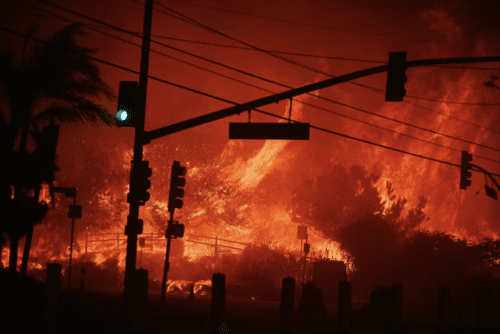
Why Fire-Prone Communities Need Community Microgrids Now
This blog post explains the crucial need for Community Microgrids in fire-prone regions.
Why Fire-Prone Communities Need Community Microgrids Now
This past January, the communities of Altadena and Pacific Palisades in Los Angeles County, CA were devastated by a series of wildfires that destroyed over 18,000 homes and tragically took the lives of at least 30 people. The two largest of these fires, the Eaton Fire and the Palisades Fire, both burned for 24 days due to drought conditions, low humidity, and hurricane-force Santa Ana winds. These two fires are the second and third-most destructive wildfires in California history. Given that natural disasters are becoming increasingly prevalent due to climate change, taking measures to prevent such horrible disasters from happening again must be a top priority.

“Flames overtake the intersection of Temescal Canyon and Pacific Coast Highway Fire at the Palisades Fire in Pacific Palisades California on Jan. 7, 2025.” Source: ABC News
Transmission grid equipment failures have been the culprit of numerous devastating wildfires. The 2018 Camp Fire – the most destructive wildfire in California history that wiped out the town of Paradise, CA and killed 85 people – was sparked by the failure of a single metal hook that had been holding up a PG&E transmission line. The 2023 Hawaii Wildfires that decimated the historic coastal town of Lahaina were caused by downed power lines. Because electric transmission infrastructure has repeatedly sparked horrific wildfires, the electric grid must change to avert future disasters from occurring again.
Community Microgrids offer a highly promising solution in creating a safe, disaster-resilient power grid. Community Microgrids are localized energy systems that can operate independently or in parallel with the broader power grid to serve a specific community’s energy needs. They typically integrate solar generation, battery energy storage, and smart grid controls to save the community money on energy costs during regular grid operation and provide life-saving backup power when the grid goes down. By combining the generation capabilities of solar and the storage capabilities of batteries, adequately sized Community Microgrids can provide backup power to the areas they serve indefinitely.
Community Microgrids are critical for public safety as they enable utilities to shut off power lines during high fire risk while maintaining a reliable source of power for the community. Given the track record of power lines causing some of the country’s most destructive wildfires, it is shocking that the Los Angeles Department of Water and Power (LADWP), the largest municipal utility in the country, did not have any measures in place to preemptively shut off power to areas at extreme fire risk. To make an already shocking lack of preparedness even worse, radio communications indicate that LADWP failed to quickly shut off power lines even after multiple requests from firefighters, sparking more blazes. LADWP defended itself by stating that some of its customers depend on power for vital services. Had Community Microgrids been in place, LADWP would not have hesitated to shut off its power lines.
“If we had had Community Microgrids, the utilities would have been much more rational about turning off their transmission grids when the high winds came up, and those places would have a high likelihood that they would still be there,” said Craig Lewis, Executive Director of the Clean Coalition, during a recent Clean Coalition webinar on Community Microgrids. Community Microgrids would have provided those areas with reliable, indefinite backup power, enabling LADWP to rest assured in shutting off its power lines that its customers would maintain power for vital services even during a disaster. Because of their unique ability to provide indefinite backup power, Community Microgrids are essential in advancing modern grid safety.
Going forward, building Community Microgrids must be a priority for any region threatened by natural disasters. The first Community Microgrid in California, the Redwood Coast Airport Microgrid (RCAM), saw its grand opening in June 2022. It provides an unparalleled trifecta of economic, environmental, and resilience benefits to a community in Humboldt County, CA that is located at the end of a transmission line and is vulnerable to wildfires, earthquakes, landslides, floods, and other natural disasters. In December 2022, a 6.4 magnitude earthquake struck Humboldt County, cutting off power to over 70,000 customers in the region. The RCAM remained online and maintained full power supply to its customers throughout the tremor. RCAM is living proof that when disaster strikes, Community Microgrids can save lives.
Now, Clean Coalition is working on several more Community Microgrids through California’s Microgrid Incentive Program (MIP). These Community Microgrids will be located across California from a disadvantaged community in East Los Angeles to a rural community north of San Francisco. The MIP is a great first step for Community Microgrids, though it only enables small-scale projects. If we hope to mitigate the risk of transmission infrastructure sparking wildfires and achieve life-saving energy resilience during grid outages, Community Microgrids must scale up and become widespread across regions susceptible to wildfires.

